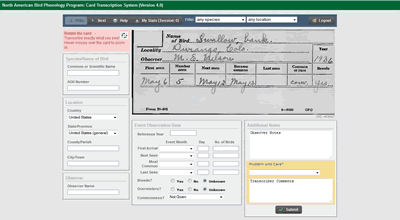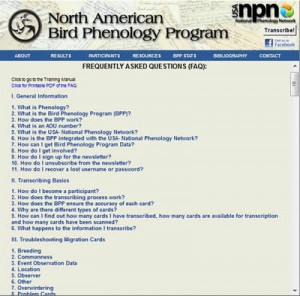
Screenshot of the transcription webpage for the North American Bird Phenology Program. Credit: U.S. Geological Survey.

Screenshot of the transcription webpage for the North American Bird Phenology Program. Credit: U.S. Geological Survey.
In 1880, a teacher named Wells Woodbridge Cooke, who was living in the Mississippi Valley, began noting the arrival dates of migratory birds. Others joined him in collecting information on bird migration; with support from the American Ornithologists’ Union, the observer network expanded across the entire United States, Canada and a portion of the West Indies.
For many years, the U.S. government supported the Bird Migration and Distribution program, but participation gradually declined, and the program closed in 1970. What remained were millions of bird migration records spanning 90 years, a treasure trove of information that we can use today to help us understand how climate change is affecting migratory birds across North America.
In response, the U.S. Geological Survey’s Patuxent Wildlife Research Center launched the North American Bird Phenology Program. Participants curate historical data from the Bird Migration and Distribution program, creating a database of avian life history and trends spanning more than a century.
Download this case study (PDF, 71KB)
Website: North American Bird Phenology Program
Project participants log in to the North American Bird Phenology Program website, where they transcribe bird migration records, adding the data to the program’s database. Once verified, all records are made available for download on the website for use by researchers and other interested individuals. Participants of all ages and from every background are welcome.

List of frequently asked questions, part of the training materials for users of the North American Bird Phenology Program. Credit: U.S. Geological Survey.
In crowdsourcing projects, participants sometimes make data entry errors, so data validity is a concern. The project therefore requires multiple participants to transcribe each record. The records are then matched to each other and to reference tables in the program’s database before being verified.
The project is helping scientists and the general public understand how climate change is affecting bird migration across North America. After several years of digitizing data, the project now provides researchers with enough information to produce a growing number of scientific publications. The studies examine particular bird species and changes in their geographic locations over time to track the impact of a changing climate on migratory birds.
Well over 400,000 records have been validated and released to the public and scientific community on the project website as well as in other data repositories. The project has a dedicated community of transcribers who spend numerous hours making transcriptions.
Sam Droege
Email: sdroege@usgs.gov